Back Issues
Click here to order back issues of Green Teacher magazine.
 |
Green Teacher 138, Winter 2024“Centering Indigenous Knowledge”Centering Indigenous Knowledge; Integrating indigenous perspectives into elementary teaching; Cheetahs and Gazelles; Dig for Your Rights!; Culture and Sustainability; The Carbon Dioxide Game; Teaching Controversial Issues; Around the World: The Invasive Species Challenge; A Working Model of a Stream; Blowing Up Your World; Climate Change Summits for Teens; The World in a Cake; Invasive Species Dodge Ball; Resource reviews |
 |
Green Teacher 137, Fall 2023“Connecting with the Land”Is Leaf Litter Just “Yard Waste”?; Composting Experiment; Enhancing Biodiversity in your Schoolyard; Nature as Refuge, Nature as Teacher; Land-Based Learning; Navigating forests and other emotional landscapes; Evolution in the Anthropocene; Why Care about Food Waste?; Environmental Games; Environmental Education and Inclusion; Resource reviews |
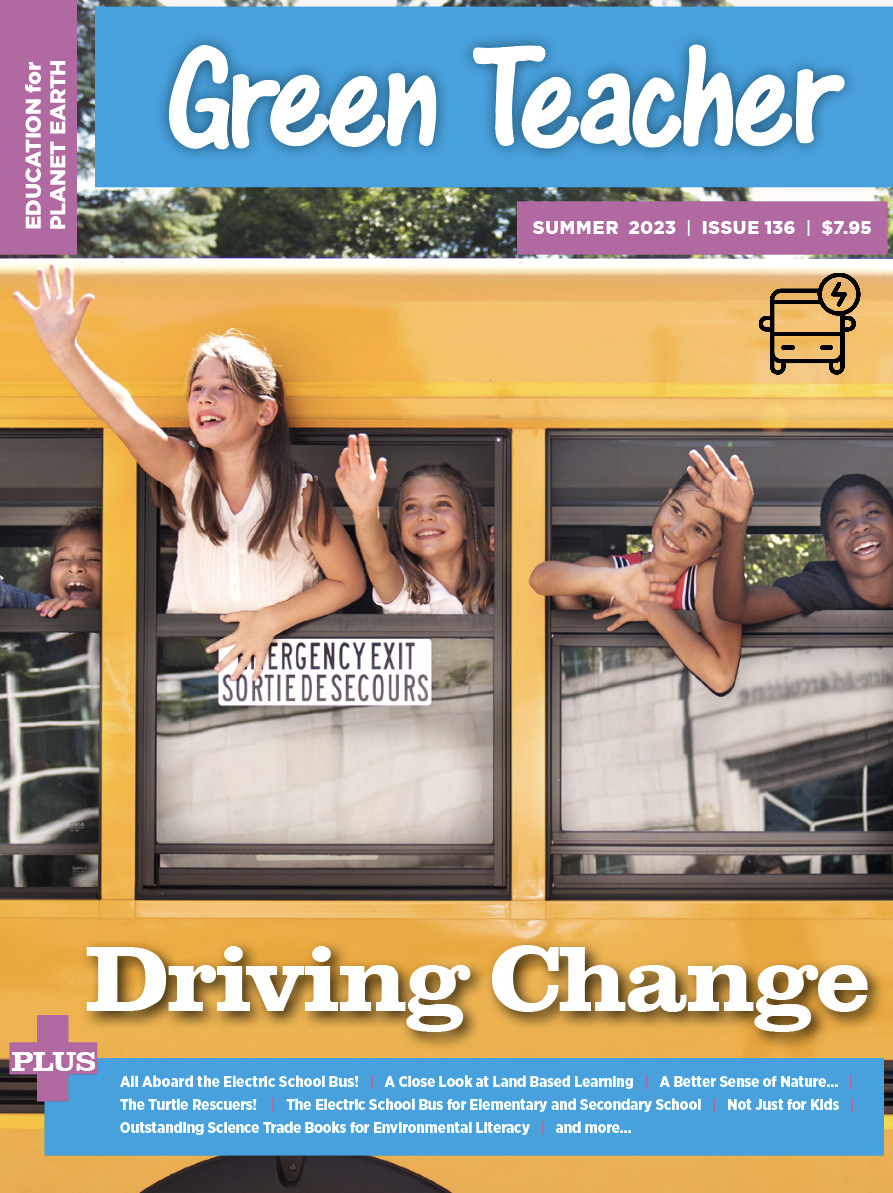 |
Green Teacher 136, Summer 2023“Driving Change”Driving Change; Driving Change… The Electric School Bus (Elementary School); Driving Change… The Electric School Bus (Secondary School); All Aboard the Electric School Bus!; A Close Look at Land Based; Not Just for; A Better Sense of Nature…; The Turtle Rescuers!; Outstanding Science Trade Books for Environmental Literacy; Resource reviews |
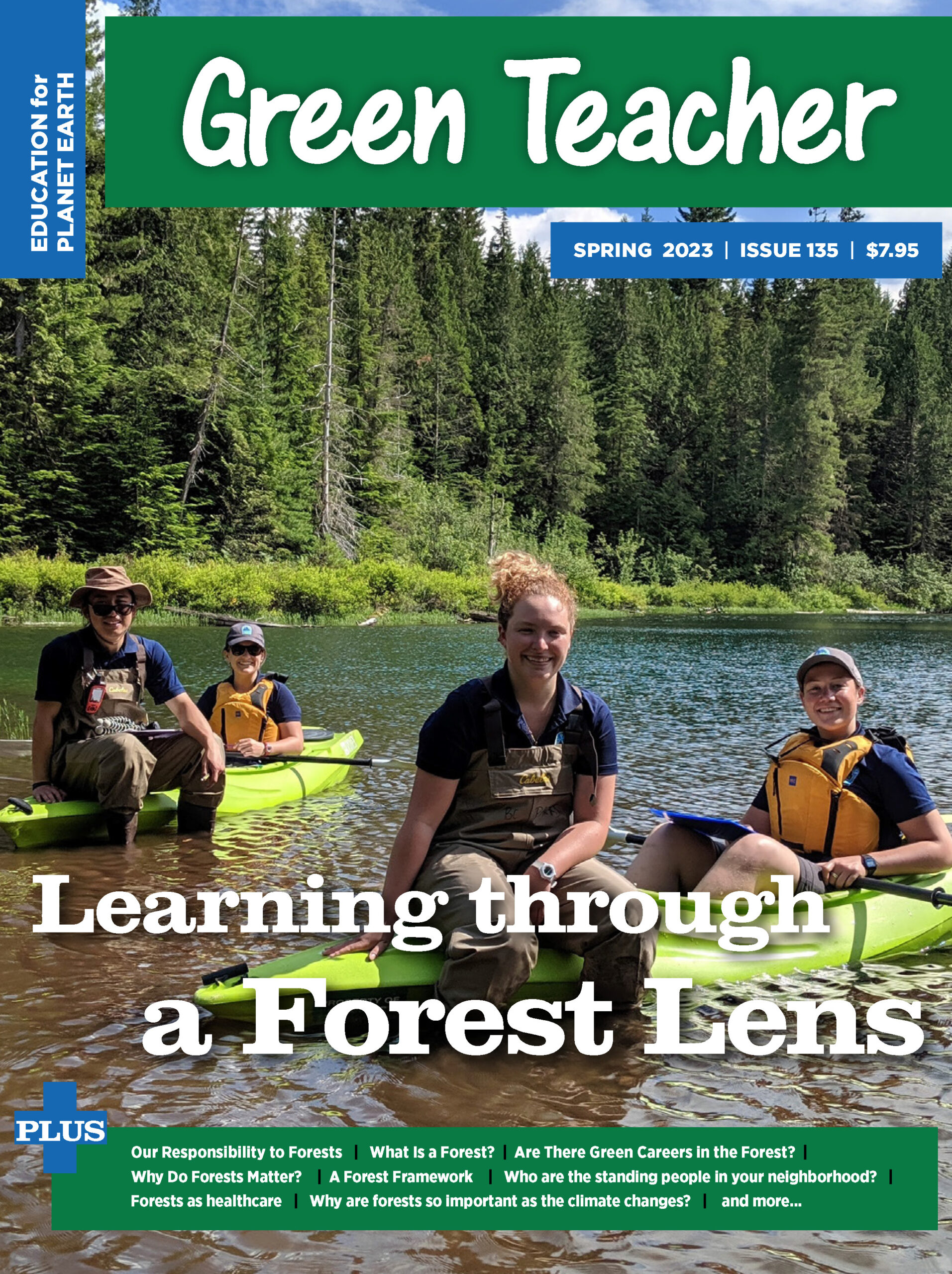 |
Green Teacher 135, Spring 2023“Learning through a Forest Lens”Our Responsibility to Forests; What Is a Forest?; Why Do Forests Matter?; Are There Green Careers in the Forest?; A Forest Framework; Forest lesson 1: Who are the standing people in your neighborhood?; Forest lesson 2: Everything you love has a name: Making friends in the forest and revitalizing lost language; Forest lesson 3: Forests as healthcare; Forest lesson 4: Why are forests so important as the climate changes?; Forest lesson 5: Why we need urban forests as the climate changes; Resource reviews |
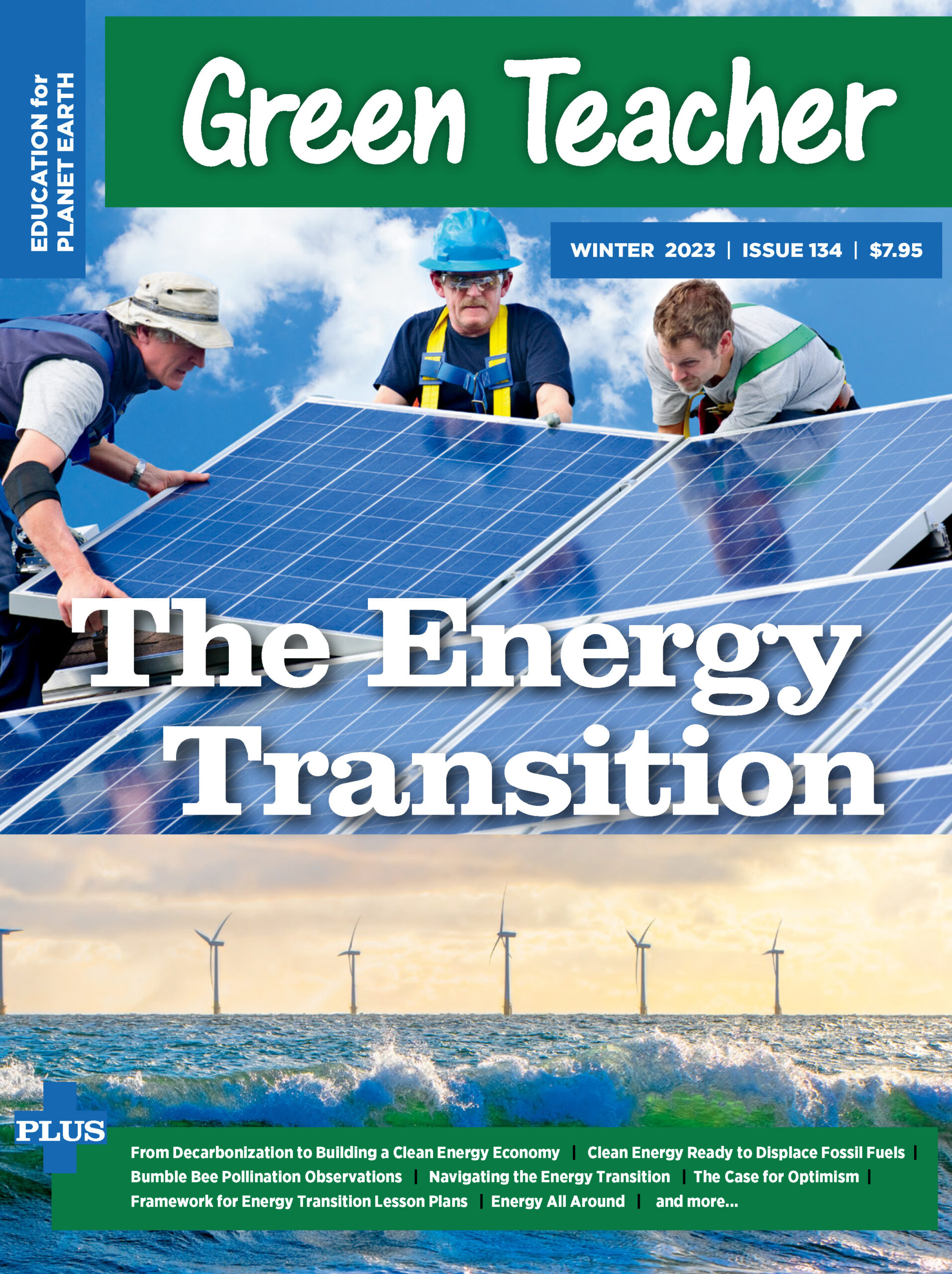 |
Green Teacher 134, Winter 2023“The Energy Transition”From Decarbonization to Building a Clean Energy Economy, Clean Energy Ready to Displace Fossil Fuels, Navigating the Energy Transition, The Case for Optimism, Framework for Energy Transition Lesson Plans, Background Information needed, Lesson One: Energy All Around, Lesson Two: Our Changing Energy Use Over Time, Lesson Three: Race to Net Zero, Lesson Four: Energy Transition Leaders, Lesson Five: Global Energy Expo, Extension Lesson: Energy Access, Autonomy, and Transition in Canadian Indigenous Communities, Lesson Six: What Does your Community Look Like in 2080?, Resource reviews |
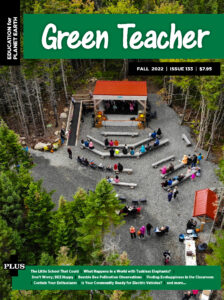 |
Green Teacher 133, Fall 2022“The Little School That Could”What Happens in a World with Tuskless Elephants?; Don’t Worry; BEE Happy; Bumble bee pollination observations; Finding Ecohappiness in the Classroom; Contain Your Enthusiasm; What Educators Need to Know About Safer Screentime and Tech-free Greentime; Is Your Community Ready for Electric Vehicles?; More from Talking with Green Teachers |
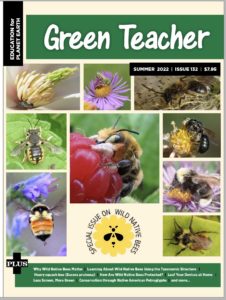 |
Green Teacher 132, Summer 2022“Special Issue on Wild Native Bees”Why Wild Native Bees Matter, The Lives of Wild Native Bees, Learning About Wild Native Bees Using the Taxonomic Structure, Hoary squash bee (Eucera pruinosa), How Are Wild Native Bees Protected?, Resources List, Activities, Pollinator Party!, Leaf Your Devices at Home, Less Screen, More Green, Conservation through Native American Petroglyphs, Healthy Places, Sustainable Spaces, More from World of Thermo |
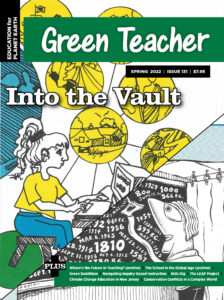 |
Green Teacher 131, Spring 2022“Into the Vault”Where’s the future in teaching?, The School in the Global Age, Green Buddhism, Navigating Inquiry-Based Instruction, Climate Change Education in New Jersey, Conservation Conflicts in a Complex World, Kids Dig, The LEAF Project, More from Talking with Green Teachers |
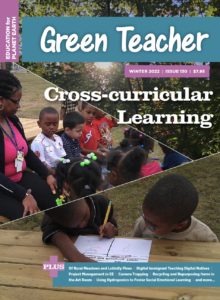 |
Green Teacher 130, Winter 2022“Cross-curricular Learning”Of Rural Meadows and Loblolly Pines, Camera Trapping, Digital Immigrant Teaching Digital Natives, Project Management in EE, Using Hydroponics to Foster Social-Emotional Learning, Recycling and Repurposing Items in the Art Room, Taking a Design Lesson from Nature, MEE and You, Inside Talking with Green Teachers |
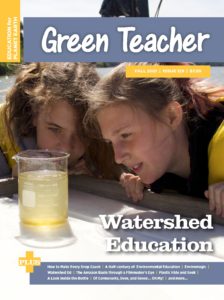 |
Green Teacher 129, Fall 2021“Watershed Education”Using Watersheds as a Framework for Learning, The Amazon Basin through a Filmmaker’s Eye, How to Make Every Drop Count, Of Cormorants, Deer and Geese… Oh My!, A Look Inside the Bottle, Plastic Hide and Seek, Watershed Ed, Enviromagic, Connecting and Reconnecting with Your Local, Informal Science Education Partners, A Half-century of Environmental Education, Schoolyard Soundwalk |
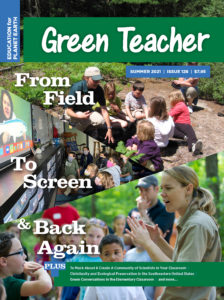 |
Green Teacher 128, Summer 2021“From Field to Screen and Back Again”From the Comfort Zone to the Twilight Zone, Working With Place, Learning Music Outside, Crouching Students, Hidden Urban Ecosystems, The HAWK’S Guide, Working Together While Apart by Aislinn Benfield, Harnessing the Whole World with Hydroponics, Inside the World of “Cli-fi”, Why We Do What We Do, Celebrating Climate Action in Schools and Child Care Programs Across Canada, Getting Serious about Climate Change in Schools. |
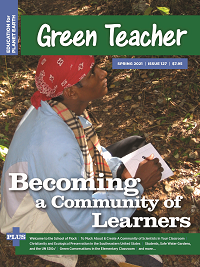 |
Green Teacher 127, Spring 2021“Becoming a Community of Learners”To Muck About & Create A Community of Scientists in Your Classroom; Richard Headstrom — STEAMING Ahead with STEM 75 Years Ago; Green Conversations in the Elementary Classroom; Water Calculator Tool; From the Individual to the System; An Inquiry-based Study of a Pipeline; Welcome to the School of Flock; Why 1°C Is a Big Deal; Nature Spots; Students, Safe Water Gardens, and the UN SDGs; and Christianity and Ecological Preservation in the Southeastern United States. |
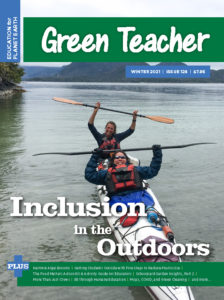 |
Green Teacher 126, Winter 2021“Inclusion in the Outdoors”Can Inclusion of Individuals with Disabilities Happen in the Outdoors?; Harmful Algal Blooms; Getting Students Outside with Five Steps to Reduce Plastic Use; The Food Matters Action Kit & Activity Guide for Educators; More Than Just Crows; Schoolyard Garden Insights, Part 2; Empowering Students through Conservation PBL; Environmental Education through Humane Education, Mops, COVID, and Green Cleaning; Money Does Grow on Plants |
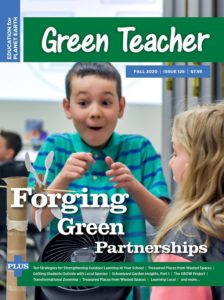 |
Green Teacher 125, Fall 2020“Forging Green Partnerships”Creating Green Partnerships to Promote Environmental Education, Ten Strategies for Strengthening Outdoor Learning at Your School, Getting Students Outside with Local Species, Developing a Relationship with the Environment — for the Health of It, Supporting Distance Learning by Connecting Children to Nature, Schoolyard Garden Insights, Part 1, The GROW Project, Transformational Zooming, Treasured Places from Wasted Spaces, Defining Ecological Identity, Learning Local |
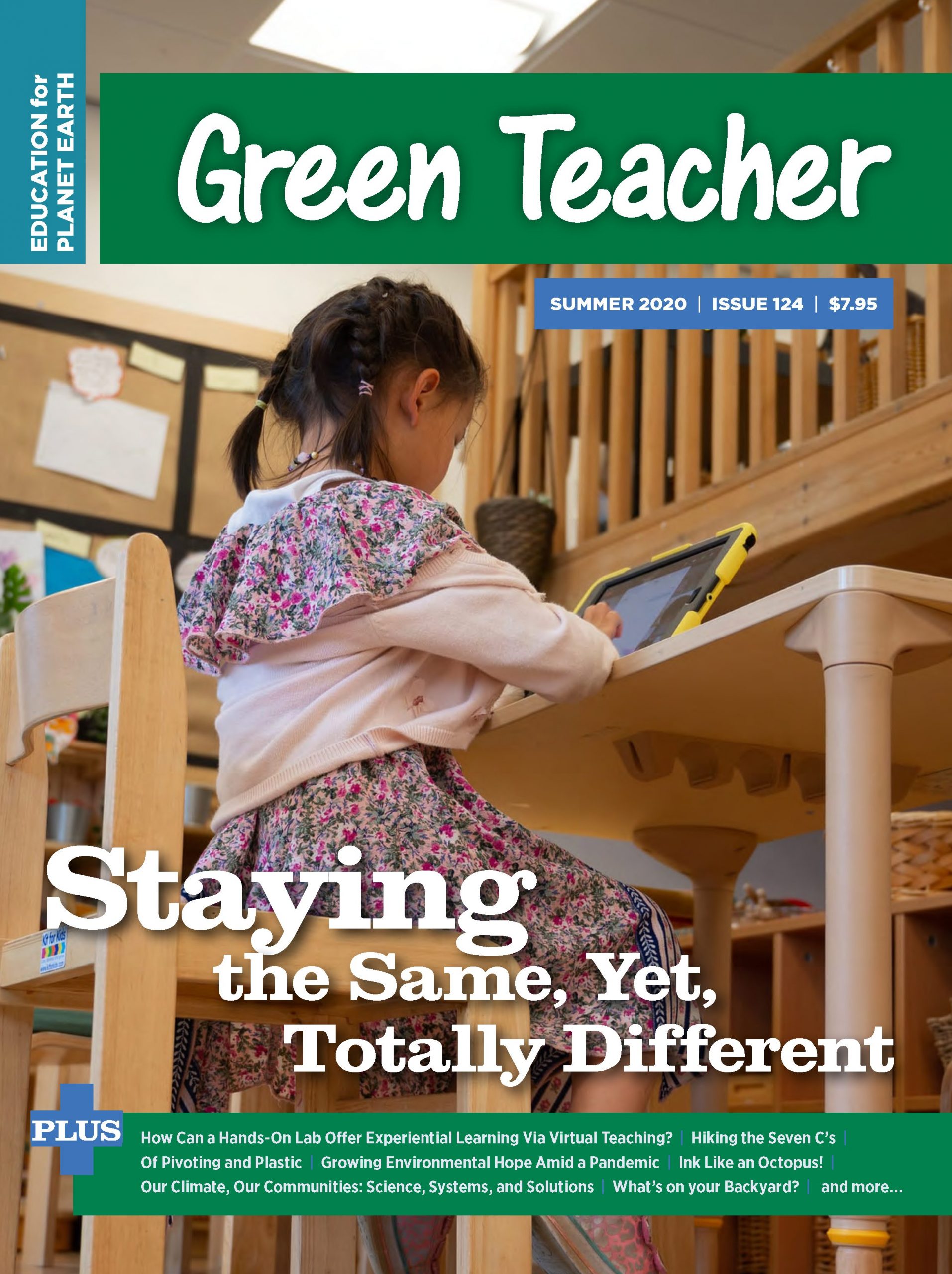 |
Green Teacher 124, Summer 2020“Staying the Same, Yet, Totally Different”Staying the Same, Yet, Totally Different, Hiking the Seven C’s, Of Pivoting and Plastic, Ink Like an Octopus!, Outdoor Virtual Classroom Choice Boards, What’s on your Backyard?, Curating Digital Museums, Growing Environmental Hope Amid a Pandemic, How Can a Hands-On Lab Offer Experiential Learning Via Virtual Teaching?, Our Climate, Our Communities: Science, Systems, and Solutions |
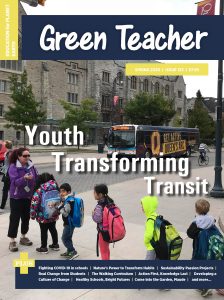 |
Green Teacher 123, Spring 2020“Youth Transforming Transit”Youth Transforming Transit, Fighting COVID-19 in Schools, Nature’s Power to Transform Habits, Sustainability Passion Projects, Real Change from Students, The Walking Curriculum, Action First, Knowledge Last, Developing a Culture of Change, Healthy Schools, Bright Futures, Come into the Garden, Maude. |
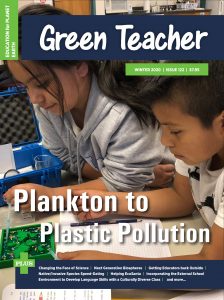 |
Green Teacher 122, Winter 2020“Plankton to Plastic Pollution”Changing the Face of Science; Next Generation Biospheres; Getting Educators back Outside; Native/Invasive Species Speed-Dating; Helping EcoSanta; Incorporating the External School Environment to Develop Language Skills with a Culturally Diverse Class; Using Live Species Around Campus to Understand Diets. |
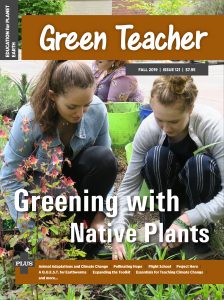 |
Green Teacher 121, Fall 2019“Greening with Native Plants”Greening Your Schoolyard with Native Plants, A Q.U.E.S.T. for Earthworms, Animal Adaptations and Climate Change, Escape the Mundane, Essentials for Teaching Climate Change, Pollinating Hope, Flight School, Project Hero and Expanding the Toolkit. |
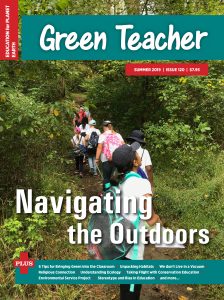 |
Green Teacher 120, Summer 2019“Navigating the Outdoors”Unpacking Habitats, Understanding Ecology, We Don’t Live in a Vacuum, Religious Connection, From Garbage to Green, Taking Flight with Green into the Classroom, Environmental Service Project, Stereotype and Bias in Education. |
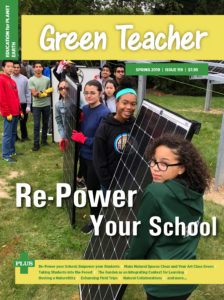 |
Green Teacher 119, Spring 2019“Re-Power Your School”Re-Power your School, Empower your Students, Make Natural Spaces Clean and Your Art Class Green, Taking Students into the Forest, The Garden as an Integrating Context for Learning, Hosting a NatureBlitz, Enhancing Field Trips, Natural Collaborations, Earth Partnership: Indigenous Arts and Sciences, The Health Risks Posed by Diesel Bus Emissions. |
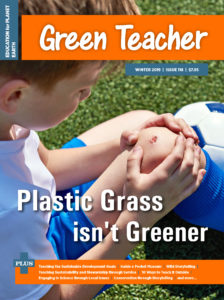 |
Green Teacher 118, Winter 2019“Plastic Grass isn’t Greener”Teaching the Sustainable Development Goals; Inside a Pocket Museum; Wild Storytelling; Teaching Sustainability and Stewardship through Service; 10 Ways to Teach It Outside; Engaging in Science through Local Issues; Conservation through Storytelling; When Two Trails Merge; Using Teacher Training to Create a Sustainability Class. |
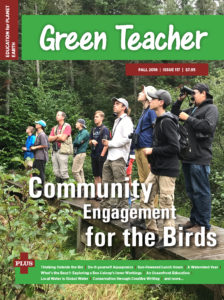 |
Green Teacher 117, Fall 2018“Community Engagement for the Birds”Community Engagement for the Birds!; Thinking Outside the Bin; Do-it-yourself Aquaponics; Sun-Powered Lunch Hours; A Watershed Year; What’s the Buzz: Exploring a Bee Colony’s Inner Workings; An Oceanfront Education; Local Water is Global Water; Conservation through Creative Writing. |
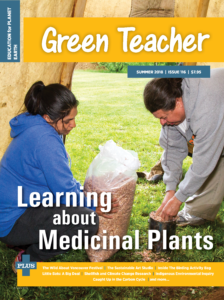 |
Green Teacher 116, Summer 2018“Learning about Medicinal Plants”Maskwi’omin: A Birch Bark Antibiotic, The Wild About Vancouver Festival, The Sustainable Art Studio, Little Bats: A Big Deal, Shellfish and Climate Change Research, Indigenous Environmental Inquiry, Inside The Birding Activity Bag, Caught Up in the Carbon Cycle. |
 |
Green Teacher 115, Winter 2018“A Better World through Fair Trade”A Better World though Fair Trade, A Systems Activity about Our Universe, Hydroponics for Education, Interviewing a Sea Lion, Engaging Bodies, Minds, and Cultural Identities, Leveraging Impact through Policy Changes, Timely Turtle Teaching, Culture, Justice, and Environment, Using Philosophy to Think Green, From Seeds to Schools in Japan. |
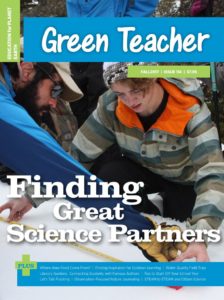 |
Green Teacher 114, Fall 2017“Finding Great Science Partners”Secrets to Snagging Great Science Partners; Where Does Our Food Come From?; Finding Inspiration for Outdoor Learning; Water Quality Field Trips; Rooting Readers in the Literary Garden; Tips to Start Off Your School Year; Let’s Talk Fracking; Fostering Connections to Freshwater Ecosystems; Observation-Focused Nature Journaling; STEM to STEAM and Citizen Science. |
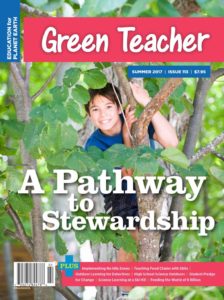 |
Green Teacher 113, Summer 2017“A Pathway to Stewardship”The Pathway to Stewardship; Partnering with Ski-Hills for Active Learning; Secondary Science Outdoors; Lights, Camera, Action!; Pledging for Change; Eco-Detectives; Plug Kids in to Nature; Natural Colours from Plants; Turn the Key To Be Idle Free; The Future of Evolution; Feeding Plants to Feed the World |
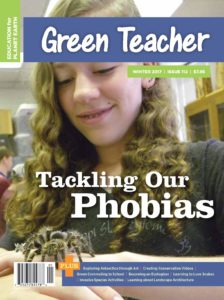 |
Green Teacher 112, Winter 2017“Tackling Our Phobias”Why Learn about Insects?; Snakes Alive!; Green Commuting Challenge; Conservation Animation; Citizenship-building via Marine Debris Surveys; Finding a Place for Science; Introducing Students to Landscape Architecture; Invasive Species: You’re Not Welcome Here!; Taking Action Against Invasive Species; Exploring Antarctica through Art; Becoming an Ecologiser |
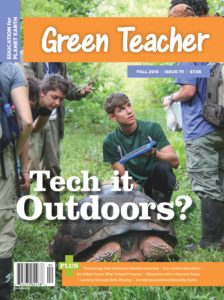 |
Green Teacher 111, Fall 2016“Tech it Outdoors”To Unplug or Plug in; Sensory Tours; Exploring Learning Stories; Rolling Stones & Catching Beetles; Ecojustice Education through Pictures; A Humane-Inspired Approach; Wild in the City; Role-Playing, Inquiry and Food Chains; An Intergenerational Care Game; Riding the Waves of EBE |
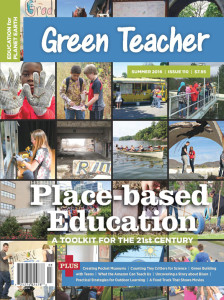 |
Green Teacher 110, Summer 2016“Place-based Education: A Toolkit for the 21st Century” (Out of stock – Print)Venturing Beyond the School; The Giving of the Gardens; Fostering Youth Leadership In Urban Places; Think Locally, Explore Globally; Problems in Our Backyard; The Bison Range Project; You Can Do It: Taking Kids out of the Classroom; Igniting Curiosity with Pocket Museums; Stewardship in Appalachia; A Reel-y Authentic Food Truck; Falling Arthropods and Citizen Science; Green Building: Tools for the Future |
 |
Green Teacher 109, Spring 2016“Time for Risky Play?”The Importance of Children’s Risky Play; Learning to be Gentle Giants; Undercover Litter Picker; Discoveries in Nature Boxes; Citizen Science: Colecting Real-Life Data; Uncaging Imagination with Guerilla Geography; Best Practices for School Gardens; Integrated, Social Justice Learning for Those At-Risk; How-To Float a Classroom; Natural Chemistry – Outdoors! |
 |
Green Teacher 108, Winter 2016“De-paving Paradise?”Put Up a Paradise; Feeling the Heat; Engineering to do Nothing; Imaginative Ecological Education; A “Cap”tivating Masterpiece; STEM Learning in Your Own Backyard; Experiential Science Transforms Teens; Let the Games Begin!; From Stems to STEM; Speaking for Native Bees |
 |
Green Teacher 107, Fall 2015“Slow Cooking with Kids”Slow Cookers for Kids, Stories in the Data, Living Deep & Sucking Out the Marrow, Exploring by the Seat of Our Pants, A Lean Green Sun Harvesting Machine, Climate Justice in the Classroom, Inspiring the Bioregional Imagination, Love Our Coral Reefs, Take the Green Challenge, Teaching Empathy Through Animals |
 |
Green Teacher 106, Spring 2015“Finding one’s place”Reading the World, Not Just the Words; Taking Kids to the Community; From Blackberry Patches to Blacktop; Green Teachers & Brown Rivers; Harvesting Life Lessons; Kids Care About Caves!; Bee Curious; “Shoot” down nature-deficit disorder; Mapping Watersheds; Celebrating World Oceans Day |
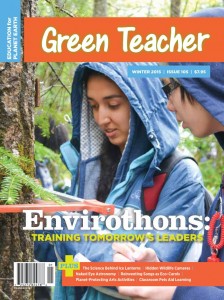 |
Green Teacher 105, Winter 2015“Envirothons: Training Tomorrow’s Leaders”Training Tomorrow’s Green Leaders; Star Hopping; From Liquid to Solid and Back Again; Planet Protecting Superheroes; Eyes in the Forest; Surveying Garlic Mustard; Creating Collaborative Curriculum; A Reflection on Forest Experiences; EcoCarols: A Creative Approach to Reinvention; Pets and Pedagogy; Returning to the Earth |
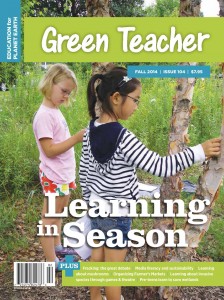 |
Green Teacher 104, Fall 2014“Learning in Season”Science in Season; Sustainability Education and Media Literacy; Fracking: Unlocking the Great Debate; Twenty Minutes with a Mushroom; Organizing Youth Farmer’s Markets; Five Tools for Classrooms Without Walls; Every Species Has a Purpose; Wetland Warriors; Understanding Micro Particles in the Ocean; Plant Wars: Invaders of the Lost Park; Around the World: The Invasive Species Challenge |
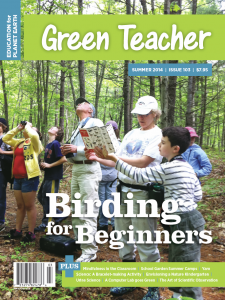 |
Green Teacher 103, Summer 2014“Birding for Beginners”Birding for Beginners; Mindfulness in the Classroom; Starting a School Garden Summer Day Camp; Rethinking Sustainability with Post-it Notes; Mapping for Change; Urine Science: The Human Body as Recycling Machine; The Art of Observation: Developing Scientific Inquiry Skills; Art, Science, and Fun Intertwined: A Bracelet-making activity; Outside the Classroom, Adventure Awaits; Envisioning a Nature Kindergarten; A Computer Lab Grows in San Francisco |
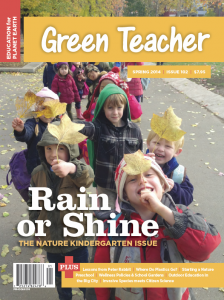 |
Green Teacher 102, Spring 2014“Rain or Shine: The Nature Kindergarten Issue”Why a Nature Kindergarten; Embodying Permaculture; Ten Steps to Starting a Nature Preschool; Risk Assessing Outdoor Areas; Finding Peace and Serenity in the Woods; The Kinder-Gardeners; Exploring the Seasonal Movement of Birds; Developing Character through Ancient Wisdom; Where Does the Plastic Go?; Let Peter Rabbit Play in the Garden; Creating School Gardens the Last; Tackling Invasive Species Using Citizen Science |
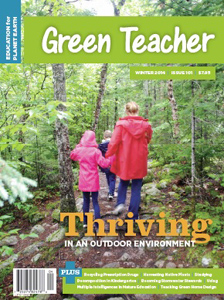 |
Green Teacher 101, Winter 2013-2014“Thriving in an Outdoor Environment”Accommodating those with Special Learning Needs; Fostering Leadership for Sustainability; Using Multiple Intelligences to Promote Nature Education; A Kindergarten Study of Decomposition; Wild Harvesting and Traditional Ecological Knowledge; Developing an Interdisciplinary High School Program; Active Students, Passive Solar; The Prescription Pill and Drug Disposal Program; Stormwater Stewards; Build A Home |
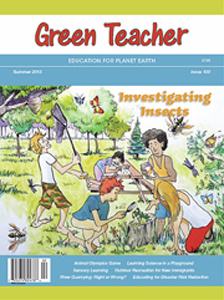 |
Green Teacher 100, Summer 2013“Investigating Insects”Connecting with Bugs; An Outdoor Play and Learn Area; New, Country, New Home, New Nature, Investigating River Quarrying; Beyond Eco-Footprints; Educating for Disaster Risk Reduction; Wildlife Olympics; Sensory Learning |
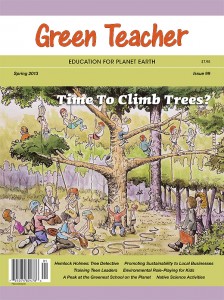 |
Green Teacher 99, Spring 2013“Time to Climb Trees?”Climbing Trees; Hemlock Holmes: Tree Detective; Doing Business in Birmingham; Training the Next Generation of Leaders; The Nature Study Movement; When Nature Speaks: Role Playing; Green School in Bali; Coconutty Classes; Two-Eyed Seeing as a Way of Knowing; Butterflies and Biomimicry; Visualizing More Sustainable Futures |
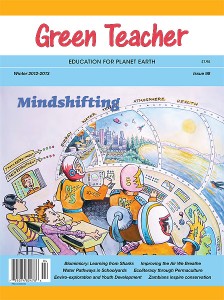 |
Green Teacher 98, Winter 2012-2013“Mindshifting”MindShift; From Restoration to Resilience; Zambian Girl Inspires Water Action; Engaging Youth in Biomimicry: Concrete Without Quarries; Swimming with Sharks; Improving the Air We Breathe; Investigating Waterpathways in Schoolyards; Ecological Literacy Through Permaculture; Environmental Exploration and Youth Development; Sustainability Education in Classrooms |
 |
Green Teacher 97, Fall 2012“Time for Yoga”Yoga in the Classroom; Hands-on Learning with Bio-char; The Environmental Impact of the Tar Sands; Children’s Rights and Climate Change; The Mystery of the Missing Mayflies; Salad Farmers; Signature Salads; To Monitor or Not to Monitor; Defending Place-based Education |
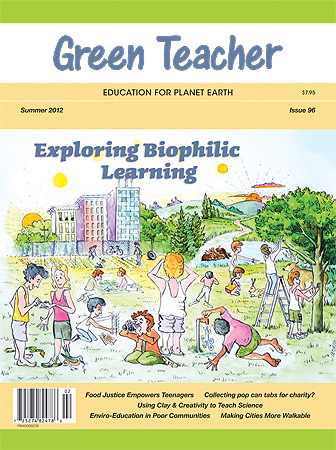 |
Green Teacher 96, Summer 2012“Exploring Biophilic Learning”Exploring the Twin Landscapes of Biophilic Learning; Pedestrian City; Letterboxing; Environmental Education in Impoverished Communities; Food Justice Empowers Teenagers; Connecting Art and Science; Endangered Animals and Science Literacy; Mapping to Increase Student Awareness of Local Wildlife; Collecting Pop Can Tabs for Charity; Herpetologoy for High School Students |
 |
Green Teacher 95, Spring 2012“Minding Their Minds”Minding Their Minds; Zero Waste for Schools; Manual Geographic Information System (GIS) Activities; The Rio+20 Earth Summit & Youth; Fostering Students’ Water Wisdom; Beyond Disaster Relief; Reflective Sit Spots; The Environmental Impact of Pets; The Pet Waste Project; The Power of Cladistics; Follow the Light Energy from the Sun; A Peaceful Classroom through Feng Shui |
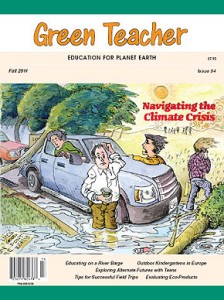 |
Green Teacher 94, Winter 2011-2012“Navigating the Climate Crisis”Unleashing Blessed Unrest As the Heating Happens; Waldkindergarten in Germany; No Accident: Successful Field Trips; Parties, Praise, and Plastic Bottles; Evaluating & Promoting Eco-Products; The Learning Barge; Exploring Alternate Futures; Assessment & Evaluation for Outdoor/Enviro-Education |
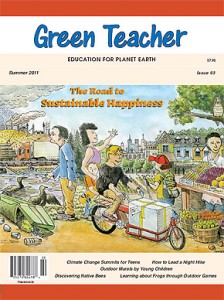 |
Green Teacher 93, Summer 2011“The Road to Sustainable Happiness”Sustainable Happiness; Bear Beach Camping Trip; Amphibians and Two Game Structures; Directed Outdoor Murals on Schools; Rewriting Our World; Climate Change Summits for Teens; Climántica: A Web 2.0 Education Project; Nighttime Adventures; Discovering Native Bees; Star Power |
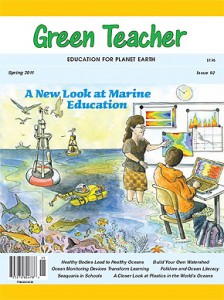 |
Green Teacher 92, Spring 2011“A New Look at Marine Education”Facilitators of Fascination; Beyond our Beaches: Ocean Trash; Marvelous Mangroves; Healthy Bodies, Healthy Oceans; Environmental Justice in the Azores; The Ocean – Live! Anywhere! Anytime!; Rocking the Classroom from the Ocean; Real-time Teaching with VENUS and NEPTUNE; Putting Marine Science on the Map; Seaquaria in Schools; Invisible World: Exploring Microscopic Life in the Ocean; Monitoring Coral Reefs using Quadrats; Watershed Stewardship through Hands-on Exploration; Using Folklore to Promote Ocean Literacy |
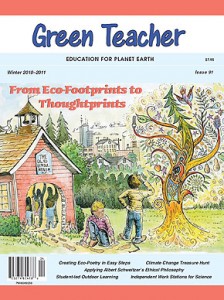 |
Green Teacher 91, Winter 2010-2011“From Eco-Footprints to Thoughtprints”From Footprints to Thoughtprints; Going Out; Creating Poetry with an Environmental Theme; Climate Change Treasure Hunt; Step Outside For Learning; Dig, Measure and Observe; A Plastic Bottle Greenhouse; Learn from My Mistakes; From Newcomer to Environmental Citizen; Transformation is in Our Hands; Participatory Eco-Drama |
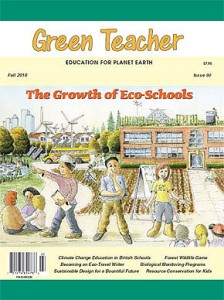 |
Green Teacher 90, Fall 2010“The Growth of Eco-Schools”Green Schools Programs; Climate Change Education in Worcestershire Schools; Local Lore; An Inquiry Lesson in Resource Conservation; Biosphere Education; Tales from the Trail; Biological Monitoring Programs for K-12 Students; Wonderful Wildlife Web; Sustainable Design for a Bountiful Future |
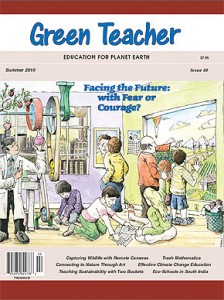 |
Green Teacher 89, Summer 2010“Facing the Future: with Fear or Courage?”Fear and Facing the Future; Growing Behavior Change; Localism as a Guiding Framework for Schools; Rethinking Climate Change Education; Inspiring Eco-Clubs in South India; Teaching Sustainability with Two Buckets; Connecting to Nature through Art; The Mathematics of Trash; A Window into the Wild |
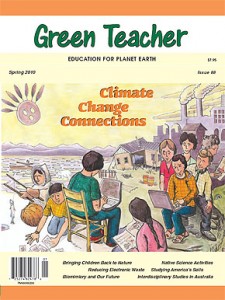 |
Green Teacher 88, Spring 2010“Climate Change Connections”First Person Singular: Documenting Climate Change; Sustainable Futures: An Interdisciplinary Unit at the Australian Science and Maths School; Introducing Biomimicry; Stop the E-Waste Crisis: Engaging the Technological Generation; Bringing Children Back to Nature; Map Interpretation and the Language of Maps; Getting Down and Dirty: Studying Soil Samples from Around the Country; Developing a Sense of Place Through Native Science Activities |
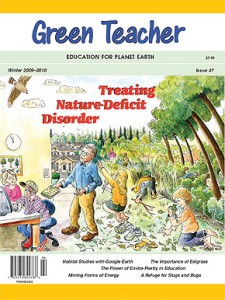 |
Green Teacher 87, Winter 2009-2010“Treating Nature-Deficit Disorder”Last Child in the Woods, First Book in the Field; Analyzing Wildlife Habitat with Google Earth; Poetry Power: Using Poems in Environmental Education; For Slugs’ Sake: Making a Refuge for Slugs, Bugs and Other Invertebrates; Key Terms in Environmental Fields: Establishing a Foundation; From Seals to Snails: Understanding Eelgrass; The Hawk in the Nest; Acting Out Energy Forms |
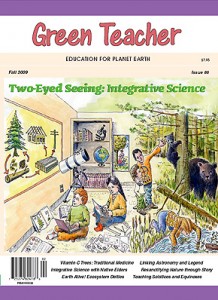 |
Green Teacher 86, Fall 2009“Two-Eyed Seeing: Integrative Science”Two-Eyed Seeing: A Cross-cultural Science Journey; MSIT: Transdisciplinary, Cross-cultural Science; Traditional Medicines: How Much is Enough?; Traditional Legends: Meanings on Many Levels; Earth Alive!; From Scared to Sacred: Changing our Relationship to Nature through Story; Bridging the Gap: Integrating Indigenous Knowledge and Science; Mother Earth, Grandfather Sun; Money From the Sea: A Cross-cultural Indigenous Science Activity; Two-Eyed Seeing in a School District |
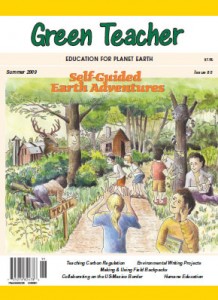 |
Green Teacher 85; Summer 2009“Self-Guided Earth Adventures”Creating Earth Adventures: Self-Guided Programs to Connect Children with Nature; Humane Education: A Foundation for Connecting with All of Earth’s Inhabitants; Teaching Carbon Regulation in the High School Classroom; Environmental Writing Projects: Empowering Students, Documenting the Natural World; Greening the Elementary Education Curriculum One Course at a Time; Field Backpacks; Global Green Teaching: EE Collaboration in the US-Mexico Border Region; Pedal-Power Outreach; Making Natural Connections |
 |
Green Teacher 84; Winter 2008-2009“Learning from Our Heritage”Human by Nature: Reclaiming our Natural Human Heritage; Fashioning Flora to Fiber; Our Community Geoscape: Living Sustainably; Rethinking Lunchtime: Making Lunch an Integral Part of Education; School Food Gardens in Multicultural Inner-city Settings; Imagine: Ecology and Teacher Education; Waiting For Rain or Seeding the Clouds?; Urban Gardening Renaissance; Nature Mapping |
 |
Green Teacher 83; Spring 2008“Ready for the Next Wave?”Green Tsunami Rising: Environmental Education’s Third Wave; Stormwater Runoff: Understanding the Ecological Impacts of Changing Land Uses; Planet Transit: Profit or Survival?; The TREK Program; Climate Change and Regional Geography; Water: Local Pollution, Global Confusion!; Moving Toward Sustainability? The Face of Environmental Education in Singapore; Singapore Sensory Trail |
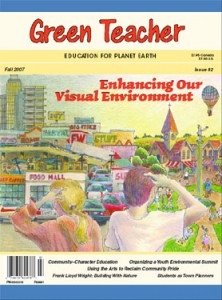 |
Green Teacher 82; Fall 2007“Enhancing Our Visual Environment”Good Design Matters; Community-Character Education; Do You See What I See?; Student “Experts” in Community Character; Using the Arts to Reclaim Community Pride; Organizing Youth Environmental Summits; Building with Nature; Environmental Education in Nepal; Community Appearance: Opportunities in the Inner City; Resolution to Advance Service-Learning |
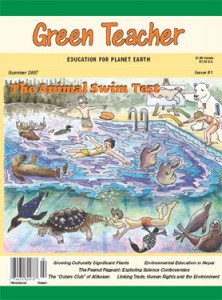 |
Green Teacher 81; Summer 2007“The Animal Swim Test”Swimming with Animals; The Peanut Pageant; Growing and Endangered Plants Network; The Outers Club; Roots of Diversity: Growing Culturally Significant Plants in the Classroom; Growing a Just Society: Linking Trade; Human Rights and the Environment; A Recipe for Outdoor Classroom Management; Environmental Education in Nepal |
 |
Green Teacher 80; Winter 2007“China Going Green?”The Start of Something Big: Environmental Education in China; Last Child in the Woods? Treating nature-defecit disorder at a high school winter camp; Making It Up As We Go Along; Getting Fresh with Farm-to-School Programs; Social Justice and Language Arts; Discovering Lake Management: Getting Students’ Feet Wet; Growing Art in School Gardens |
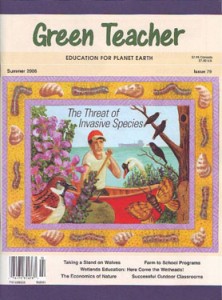 |
Green Teacher 79; Summer 2006“The Threat of Invasive Species”Exotic Invasive Species: The Guests That Won’t Go Home; A Date with Freddie Kudza; Something’s Choking Auntie Elm; Sun Block; Kids Teaching Kids: The Tantramar Wetlands Centre Project; Sunnyside and the Wolf; Valuing Nature in Environmental Education; Georgia’s Outdoor Classroom Symposium |
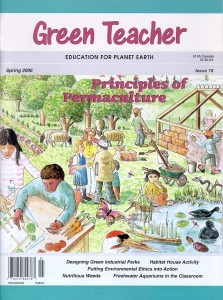 |
Green Teacher 78; Spring 2006“Principles of Permaculture”Designing green industrial parks; Habitat House activity; Putting Environmental ethics into action; Nutritious weeds; Freshwater aquariums in the classroom |
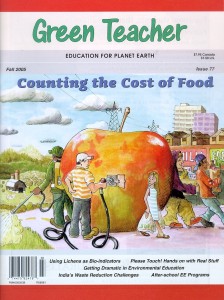 |
Green Teacher 77; Fall 2005“Counting the Cost of Food”Using lichens as bio-indicators; Please touch! Hands on with real stuff; Getting dramatic in environmental education; India’s waste reduction challenges; After-school EE programs |
 |
Green Teacher 76; Spring 2005“Bringing the Wild Inside”What if teaching went wild? (some classroom strategies); Environmental service learning; Baking a One World Cake; Guiding schools toward environmental literacy; Raptor studies with young children; Challenging corporate sponsorship |
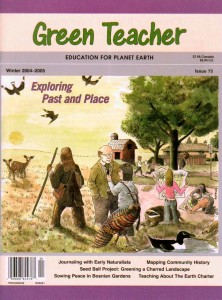 |
Green Teacher 75; Winter 2005“Exploring Past and Place”Community Questing: discovering local history; nature and culture; The journals of early naturalists; Seed Ball Project: greening a charred landscape; Sowing peace in Bosnian gardens; Teaching about the Earth Charter; En”grossing” scat studies |
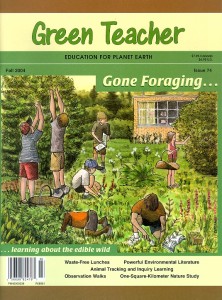 |
Green Teacher 74; Fall 2004“Gone Foraging…”Foraging for wild edibles; Waste-free lunches; Powerful environmental literature; Science libaries in the classroom; Inquiry-based learning through animal tracking; Observation walks; “Teaming with Nature”: one-square-kilometer nature studies |
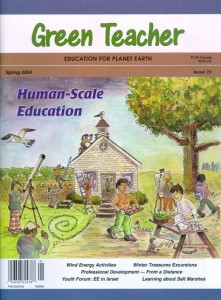 |
Green Teacher 73; Spring 2004“Human-Scale Education”Interview about “small schools” with Satish Kumar; Wind energy activities; Winter Treasures excursions; Professional development through distance learning; Learning about salt marshes; Youth Forum: EE in Israel |
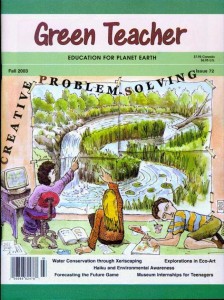 |
Green Teacher 72; Fall 2003“Creative Problem Solving”Using creative problem solving in environmental projects; Water awareness through xeriscaping; Explorations in eco-art; Haiku-writing; Forecasting the Future game; Museum internships for teenagers |
 |
Green Teacher 71; Summer 2003“The Dark Side of Light Pollution”Light pollution: environmental effects; causes and cures; Ten-day TV-Free Challenge; Investigating ants: schoolyard science activities; Integrating EE into home economics; Worm composting revisited |
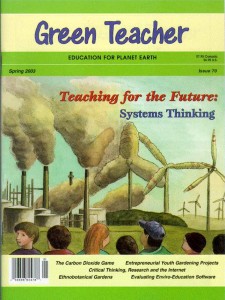 |
Green Teacher 70; Spring 2003“Teaching for the Future: Systems Thinking”Systems thinking and sustainability; The Carbon Dioxide Game; Entrepreneurial gardening projects; Critical thinking skills for Internet research; Ethnobotanical gardens; Evaluating enviromental education software |
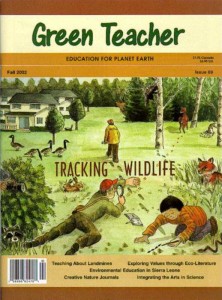 |
Green Teacher 69; Fall 2002“Tracking Wildlife”A course in wildlife tracking; Teaching about landmines; Exploring values through eco-literature; Environmental education in Sierra Leone; Creative nature journals; Integrating the arts into environmental education; Evaluating nature journals |
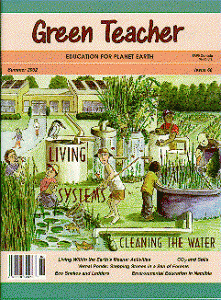 |
Green Teacher 68; Summer 2002“Living Systems: Cleaning the Water”Living machines in schools; Living within the Earth’s means (exploring wants and needs); Measuring CO2 flux in soils; Vernal ponds: stepping stones in a sea of forests; Eco Snakes and Ladders game; Environmental education in Namibia |
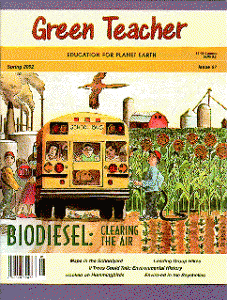 |
Green Teacher 67; Spring 2002“Biodiesel: Clearing the Air”The case for biodiesel in school buses; Soy-powered learning in high school; Painting a community map in the schoolyard; Leading group hikes; Environmental history; Learning about hummingbirds; Wildlife clubs of the Seychelles |
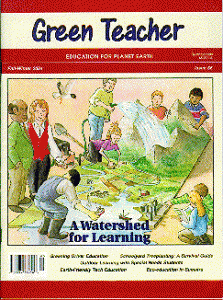 |
Green Teacher 66; Fall-Winter 2001“A Watershed for Learning”(Photocopy only) Building a watershed model; Greening driver education; Schoolyard treeplanting: a survival guide; Outdoor learning with special needs students; Earth-friendly tech education; Eco-education in Sumatra; Primary sources for environmental literature on the Internet |
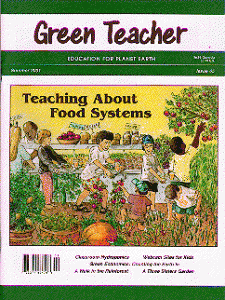 |
Green Teacher 65; Summer 2001“Teaching About Food Systems”(Photocopy only) Teaching about food systems; Classroom hydroponics; Green economics; Rain forest walk simulation; Three sisters garden; Webcam sites for kids |
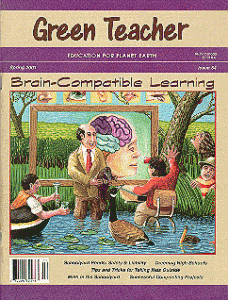 |
Green Teacher 64; Spring 2001“Brain-Compatible Learning”(Photocopy Only) Brain-Compatible Learning; Successful School Composting; Greening High Schools: Leaping Subject Barriers; Tips and Tricks for Taking Kids Outside; Moving Math Outdoors. Updated versions of most of the articles in this issue can be found in our book Greening School Grounds: Creating Habitats for Learning. |
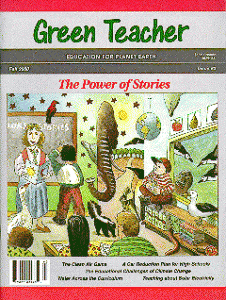 |
Green Teacher 63; Fall 2000“The Power of Stories”The power of stories in EE; Car reduction plan for high schools; Educational challenges of climate change; Clean Air game; Organizing a bikeathon; Solar electricity activities |
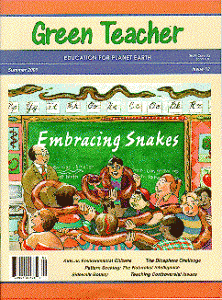 |
Green Teacher 62; Summer 2000“Embracing Snakes”Keeping snakes in the classroom; Developing ecological literacy; Learning science through patterns in nature; Young children as environmental citizens |
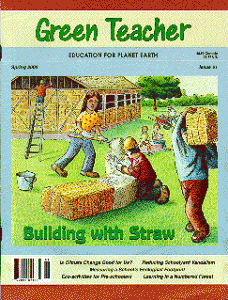 |
Green Teacher 61; Spring 2000“Building with Straw”(Photocopy only) Straw bale building projects; EE guidelines for early childhood; Discouraging vandalism in school nature areas; Bioregional treasure hunts; Measuring your school’s ecological footprint |
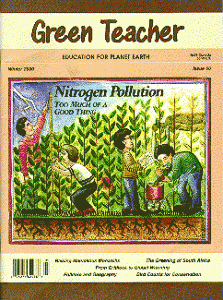 |
Green Teacher 60; Winter 1999-2000“Nitrogen Pollution: Too Much of a Good Thing”Raising monarch butterflies; Folklore and geography; Investigating nitrogen pollution; Birdathons; From gridlock to global warming -transportation alternatives; EE in South Africa |
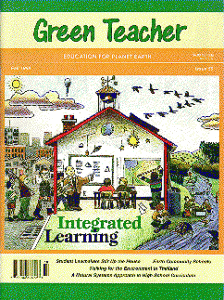 |
Green Teacher 59; Fall 1999“Integrated Learning”(Photocopy only) Integrated learning (theme); Ecology project learning; Integrated studies in systems; Community environmental involvement; Two Rivers project; EE in Thailand; Earth Community School |
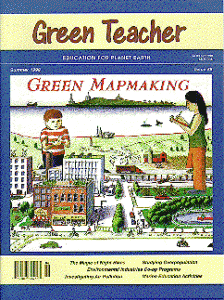 |
Green Teacher 58; Summer 1999“Green Mapmaking”(Photocopy only) Green Mapmaking; Environmental industries co-op ed.; Investigating air pollution; The magic of night hikes; Activities on oceans and seafaring |
 |
Green Teacher 57; Winter 1998-99“Development Education: Seeking a Balance”Development Education (theme); Working with NGOs; A schoolwide focus on development; Race against desertification Water issues around the world; International development and EE |
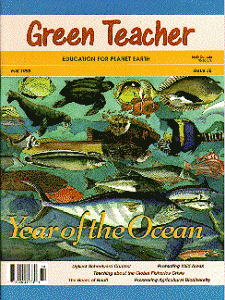 |
Green Teacher 56; Fall 1998“Year of the Ocean”Year of the Ocean (theme); Ocean pollution (activities); Studying ocean fisheries; A high school fish hatchery; Agricultural biodiversity (activities); Bears of Banff (activity); Why we need protected areas; The Ugliest Schoolyard contest; A breakthrough report for EE; Reflections of a hopeful cynic |
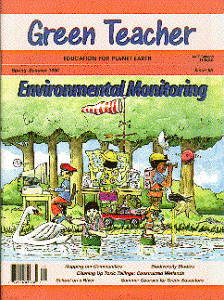 |
Green Teacher 55; Summer 1998“Environmental Monitoring”(Photocopy only) Environmental monitoring (theme); Biodiversity studies; Monitoring local rivers; wetlands; frogs; acid rain – and more; A constructed wetland project; Community mapping; The Globe program; A school on a river |
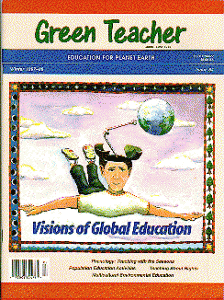 |
Green Teacher 54; Winter 1997-98“Visions of Global Education”Visions of Global Education (theme); Multicultural EE; Teaching interconnectedness (activities); Population studies; Phenology: teaching natural science with the seasons (junior high) |
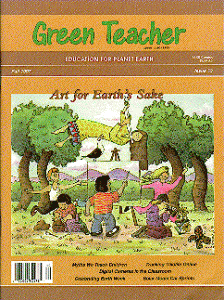 |
Green Teacher 53; Fall 1997“Art for Earth’s Sake”Rivers: exploring environmental themes through art; Tracking migratory animals online; Celebrating Earth Week (unit); Junior Solar Sprint |
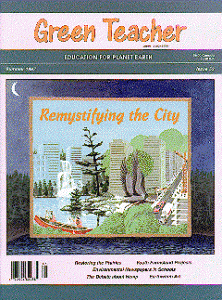 |
Green Teacher 52; Summer 1997“Remystifying the City”Remystifying the city; The debate about hemp; Prairie restoration; Great Lakes food web (play); The art of science; Creating a class newspaper |
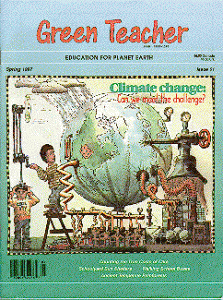 |
Green Teacher 51; Spring 1997“Climate Change: Can we meet the challenge?”(Photocopy Only) Updated versions of most of the articles that appeared in this issue are in our book Teaching About Climate Change: Cool Schools Tackle Global Warming. |
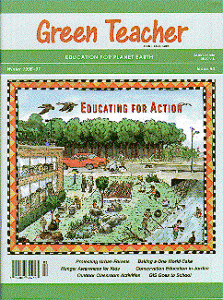 |
Green Teacher 50; Winter 1996-97“Educating for Action”Educating for action: A framework for education; GIS in high schools; Teaching about hunger; Protecting our urban forests; Activities for outdoor classrooms |
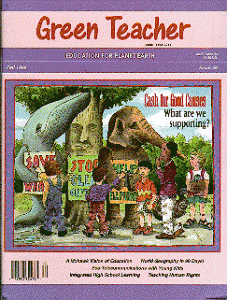 |
Green Teacher 49; Fall 1996“Cash for Good Causes — What are we supporting?”Cash for good causes– what are we supporting?; A Mohawk vision of education; Telecommunications for young children; Teaching human rights |
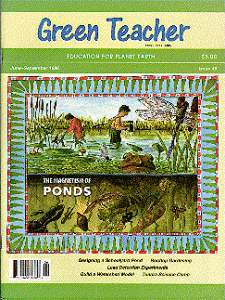 |
Green Teacher 48; June-Sept 1996“The Magnetism of Ponds”(Photocopy only) Building a schoolyard pond; Pond studies with children; How big is your ecological footprint? Rooftop gardens; Lead testing in high school chemistry; Visiting a sustainable living site; Tundra Science Camp |
 |
Green Teacher 47; April-May 1996“Transforming School Grounds”(Photocopy only) Updated versions of most of the articles in this issue can be found in our book Greening School Grounds: Creating Habitats for Learning. |
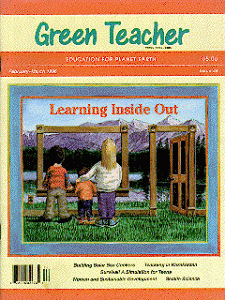 |
Green Teacher 46; Feb-Mar 1996“Learning Inside Out”(Photocopy only) Outdoor education (theme): Overcoming barriers to outdoor and environmental education; Food chains in the schoolyard; Relationships in nature; Single concept field trips; Wilderness survival simulation. |
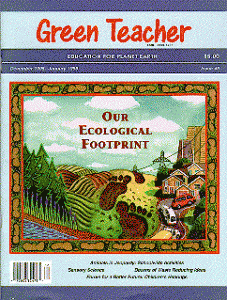 |
Green Teacher 45; December 1995-January 1996“Our Ecological Footprint”(Photocopy only) Ecological footprints: measuring human impact; How to organize a K-12 children’s hearing; Sensory science activities for K-8; Nurturing boys’ appreciation of flowers and plants |
 |
Green Teacher 44; October-November 1995“Democratizing Schools”Democratizing schools for better environmental stewardship; Guidelines for keeping animals in the classroom; Small-scale high school science: eco-friendly lab methods; Global Morning: a consumer awareness activity |
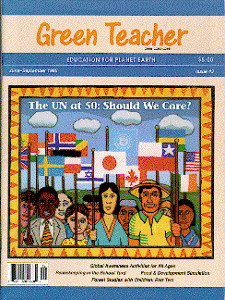 |
Green Teacher 43; June-September 1995“The UN at 50: Should We Care?”(Photocopy only) Teaching about the United Nations (K-12); Creating global superheroes (grade 6 unit) |
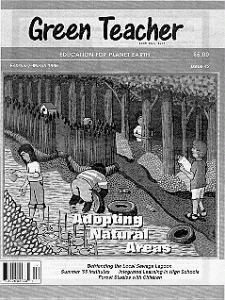 |
Green Teacher 42; February-March 1995“Adopting Natural Areas”(Photocopy only) Adopting natural areas: environmental stewardship; High school subject integration: four models; Branching out: forest studies with children, part 1; High school sustainable forestry project |
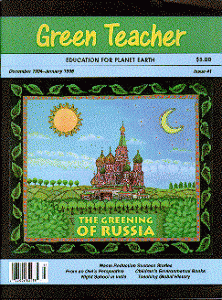 |
Green Teacher 41; December 1994-January 1995“The Greening of Russia”Environmental education in Russia; Asking the right questions about zoos; Une station météorologique a l’école; Successful waste reduction strategies |
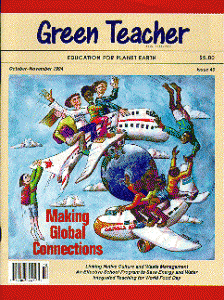 |
Green Teacher 40; October-November 1994“Making Global Connections”(Photocopy only) Interdisciplinary unit on food (junior high); Humane Education, part 2; Nova Scotia-Gambia Project (third world exchanges); Environmental sensitivities in the classroom |
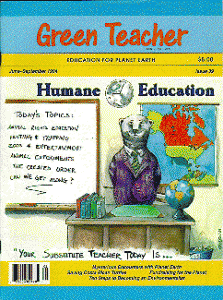 |
Green Teacher 39; June-Sept 1994“Humane Education”(Photocopy only) Humane Education, part 1: Animal rights activities; Ten steps to becoming an environmentalist; The storyline approach in earth education; North America’s environmental education organizations (listing) |
 |
Green Teacher 38; April-May 1994“The Promise of Gardening”(Photocopy only) Updated versions of most of the articles that appeared in this issue can be found in our book Greening School Grounds: Creating Habitats for Learning. |
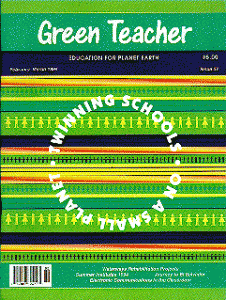 |
Green Teacher 37; Feb-March 1994“Twinning Schools on a Small Planet”(Photocopy only) School twinning projects (special theme); I*EARN: Electronic School Network; Waterways rehabilitation projects |
 |
Green Teacher 36; Dec 1993-Jan 1994“The Importance of Biodiversity”(Photocopy only) The importance of biodiversity; All-species projects; World Scientists’ Warning to Humanity; An overnight trip with first graders |
 |
Green Teacher 35; Oct-Nov 1993“Teaching about Sustainability”(Photocopy only) Teaching about sustainability (special report); Winter composting experiment; Garbage free lunch programs; The greening of high school language arts |
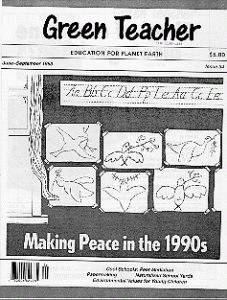 |
Green Teacher 34; June-Sept 1993“Making Peace in the 1990s”(Photocopy only) Making Peace in the 1990s: special report; Papermaking: A high school paper mill; Establishing a naturalized area in the schoolyard; Global music from local materials |
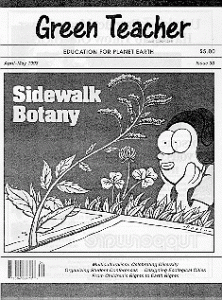 |
Green Teacher 33; April-May 1993“Sidewalk Botany”(Photocopy only) Sidewalk botany; Multiculturalism theme: ideas and activities; Designing a green city (secondary project); Child rights-Earth rights (grade 4-6 unit) |
Leave a Reply
You must be logged in to post a comment.





Someone specifically help to create substantially blogposts I’d talk about.. pizza delivery near me Be the first-time My spouse and i went to your online site and thus far? We stunned while using evaluation you have made to build this unique post amazing. Superb approach!